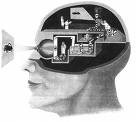During the past year, I have made many discoveries about my philosophy of teaching. Before the year started, I had many thoughts on how I would plan and teach my lessons, thoughts about the
type of teacher I wanted to be. Once I actually got into the classroom, all of
that changed.
I quickly realized that standing in front of a group of students and lecturing, just wasn’t working. My students wanted to be challenged and engaged.
I wanted to challenge and engage them. They wanted their ideas to be a
part of the curriculum. After first greeting this idea with some reservations,
I saw the positive results that problem-based learning had and became more receptive to some of their suggestions. Notice, I say some, not all. I knew that I still had a responsibility
to ensure that what I was teaching would prepare them for the end-of-year assessments.
It was important to me that I balanced creativity with successfully teaching the standards. My ultimate goal became
to create an environment that would make them want to learn.
The educational philosophies were a daily struggle for me. By
incorporating the best of each of these philosophies, I was able to ensure my students learned the “classics”
without becoming bored while being able to allow them to have input into what they learned and how they learned it. I wanted a classroom where creativity ruled in successfully meeting the learning objectives I set for my
students. It was the hardest work I’ve even done, but I felt that my students ended the year feeling that you can learn
about Shakespeare and have fun doing it.
I learned to let go of the “lesson plan”. There
were many days when I found myself frustrated that I hadn’t completed what I had set out to do but when I realized that
very often the detours we took were just as beneficial to learning as what I had planned.
I realized that life isn’t always structured and that it wouldn’t be so for my students in the real world. Teaching them adaptability would help them in their problem solving skills.
I am a firm believer in differentiated instruction and feel that it’s best to develop plans to
accommodate for this. Again, this required more planning on my part, but my students
deserve the opportunity to learn as much as they can in the same classroom as their peers.
Having worked in the corporate world for many years, I have found myself paying particular attention
the news on budgets and standards, fully aware that the decision that are made outside of my control, can and will ultimately
affect my classroom. It was sad, but I had to admit that many school systems
are run no different than many businesses and I felt that I needed to be prepared for what may, or may not, come.
I’d like to end with my thoughts on technology. I
don’t see how we can prepare the students of today to be successful adults tomorrow if we don’t incorporate the
21st Century learning skills into our curriculums. Integrating technology
into the curriculum will not only help prepare our students to be critical thinkers but also introduce them to the information
skills they not only need now, but will need when they enter the employment arena. We
need to keep them competitive with students from other nations as we are lagging way behind.
One of the main reasons I decided to make a career switch and enter the teaching profession was due to
the excitement I felt when I saw the possibilities education could have with the integration of technology into it. It’s exciting to see that New Jersey is starting to incorporate this into its standards
and I’m glad to be a part of the change.

